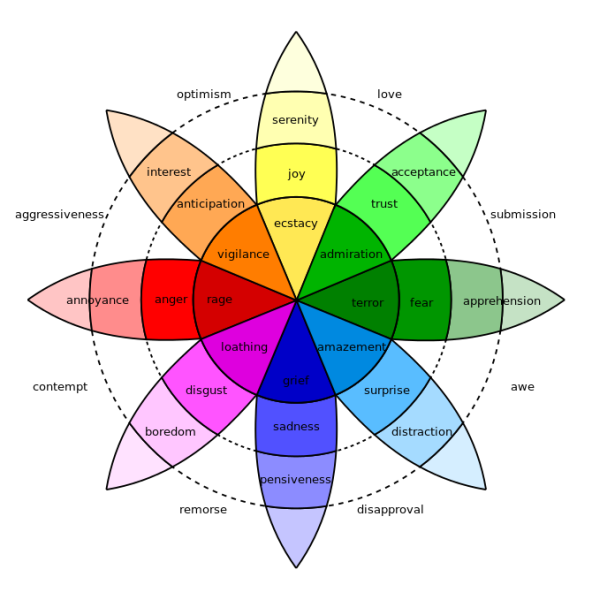If you’re wondering what colour to use with your brand or which colour to paint the office, think carefully because the colours you choose can affect your ability to achieve your goals.
There’s been a lot written about colour psychology, some proven hypotheses and some mere hunches. What we do know is; colour can greatly effect human emotion and behaviour.
The power of colour
From a marketing perspective, if colour can affect human behaviour, that’s powerful stuff. But here’s the tricky part: just like language, the meaning of colour can vary across cultures and perceptions. Before tweaking your brand or painting your premises, research the meaning (and therefore the effect) your chosen colour may have on your business.
Generalising colour psychology

Robert Plutchik’s Wheel of Emotions (Photo credit: Wikipedia)
Robert Plutchik created The Wheel of Emotions. The Wheel is used to illustrate different emotions. Plutchik first proposed his cone-shaped model (3D) or the wheel model (2D) in 1980 to describe how emotions were related.
He suggested 8 primary bipolar emotions: joy versus sadness; anger versus fear; trust versus disgust; and surprise versus anticipation. Additionally his model makes connections between the idea of an emotion circle and a colour wheel. Like colours, primary emotions can be expressed at different intensities and can mix with one another to form different emotions.
The Wheel of Emotions should is open to interpretation. It was created in the 1980s (around 35 years ago), and it’s safe to say perceptions have changed.
The changing perception of colour
We asked clients and colleagues, read numerous articles and teachings as well as used our own perceptions and knowledge to update the generalised colour psychology from a K.I.S.S perspective.
Red is often associated with the colour of energy, passion, action, ambition and determination. It can also be associated with anger, rage and annoyance. Online, red is often associated with call to action and conversions.
Orange is associated with social communication, technology and optimism.
Yellow is the colour of the mind. It’s optimistic and cheerful.
Green is the colour of balance, growth and innovation.
Blue is associated with trust and peace. It can suggest loyalty and integrity as well as conservatism, which is why you see blue in a lot of corporate organisations.
Purple is the colour of the imagination. It can be creative and individual.
Brown is friendly, down-to-earth and is associated with security, protection, comfort and material wealth.
Grey is compromise. Nor black nor white, it’s the transition between two non-colours. It’s unemotional.
Silver has a feminine energy; it is related to the moon and the ebb and flow of the tides – it is fluid, emotional, sensitive and mysterious.
Gold is the colour of success, achievement and triumph. Associated with abundance and prosperity, luxury and quality, prestige and sophistication and elegance, the colour psychology of gold implies affluence, material wealth and extravagance.
White is colour at its most complete and pure, the colour of perfection. The colour meaning of white is purity, innocence, and completion. White is said to be the one colour NOT to paint your office as staff can get bored and distracted as their thoughts wander.
Black is similar to gold in that it conjures an association with abundance, prosperity and luxury. It can also be seen as secretive, or in some cases evil.
Colour in brand
Because colour is left to perception, the colour generalisations discussed above should be considered but there are can be exceptions to the rule.
Before changing your brand to red to get more online conversions, think about how to complement your existing palette. For example, if red increase online conversions – can you use an element of red to perhaps change your call-to-action buttons? Or if orange is the colour of communication and your brand is green and blue, can you use an image style with an orange wash?
Need help deciding your colour strategy?
This article was syndicated from Business 2 Community: The Role of Colour in Brand
More Sales & Marketing articles from Business 2 Community:




